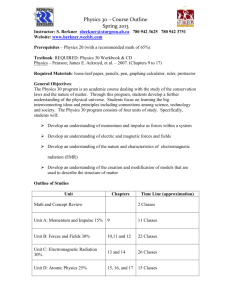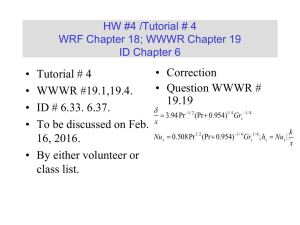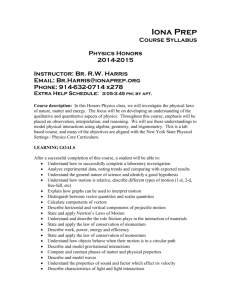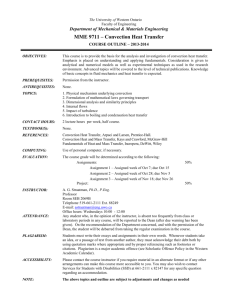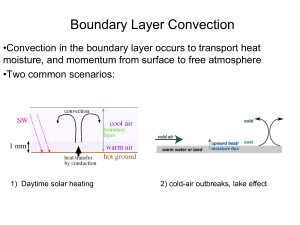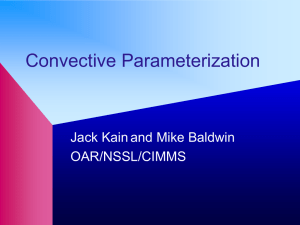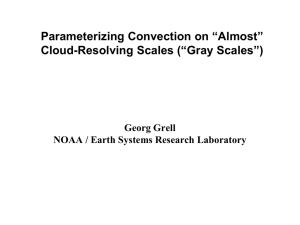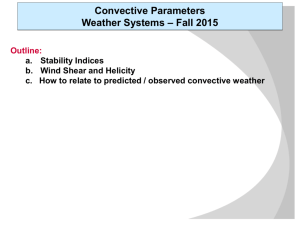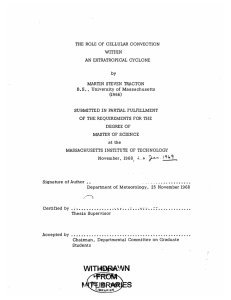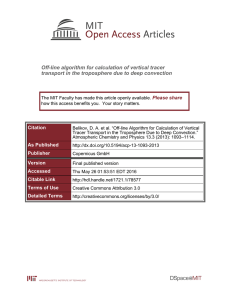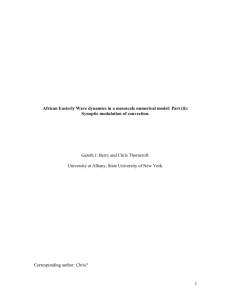ME 814 Advanced Heat Transfer
advertisement
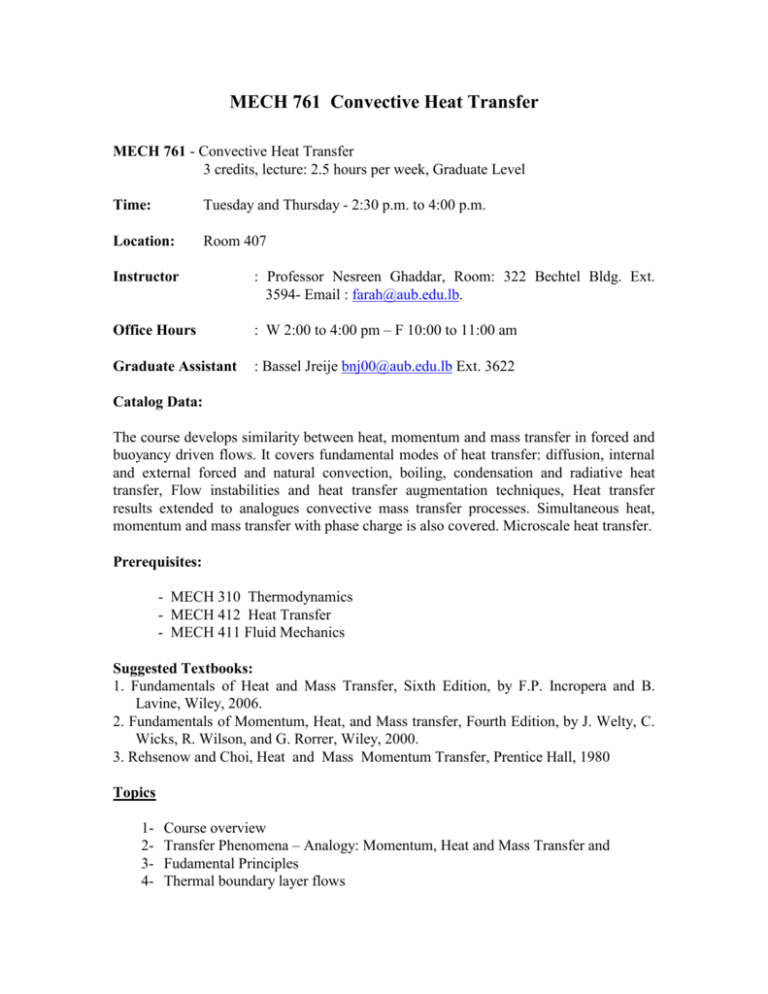
MECH 761 Convective Heat Transfer MECH 761 - Convective Heat Transfer 3 credits, lecture: 2.5 hours per week, Graduate Level Time: Tuesday and Thursday - 2:30 p.m. to 4:00 p.m. Location: Room 407 Instructor : Professor Nesreen Ghaddar, Room: 322 Bechtel Bldg. Ext. 3594- Email : farah@aub.edu.lb. Office Hours : W 2:00 to 4:00 pm – F 10:00 to 11:00 am Graduate Assistant : Bassel Jreije bnj00@aub.edu.lb Ext. 3622 Catalog Data: The course develops similarity between heat, momentum and mass transfer in forced and buoyancy driven flows. It covers fundamental modes of heat transfer: diffusion, internal and external forced and natural convection, boiling, condensation and radiative heat transfer, Flow instabilities and heat transfer augmentation techniques, Heat transfer results extended to analogues convective mass transfer processes. Simultaneous heat, momentum and mass transfer with phase charge is also covered. Microscale heat transfer. Prerequisites: - MECH 310 Thermodynamics - MECH 412 Heat Transfer - MECH 411 Fluid Mechanics Suggested Textbooks: 1. Fundamentals of Heat and Mass Transfer, Sixth Edition, by F.P. Incropera and B. Lavine, Wiley, 2006. 2. Fundamentals of Momentum, Heat, and Mass transfer, Fourth Edition, by J. Welty, C. Wicks, R. Wilson, and G. Rorrer, Wiley, 2000. 3. Rehsenow and Choi, Heat and Mass Momentum Transfer, Prentice Hall, 1980 Topics 1234- Course overview Transfer Phenomena – Analogy: Momentum, Heat and Mass Transfer and Fudamental Principles Thermal boundary layer flows 5- Modelling thermal transport processes in typical engineering systems. Simplified modelling techniques and experimental interfacing. 6- Convective Heat Transfer: Limiting Condition Flows Parallel flows (Hagen-Poiseuille Flow) Couette Flow Sudden acceleration of a flat plate Stagnation Flow Creeping flow (eg. MEMS Microfluidics) 7- Natural Convection (similarity solutions) 8- Nucleate boiling 9- Condensation 10- Mass Transfer: Diffusion & Convection 11- Comined Heat and Mass Transfer 12- Heat Transfer in Porous Media 13- Closure Objectives The objectives of the course are: (1) to provide the student with general techniques to formulate, model and mathematically solve advanced heat transfer problems; (2) to provide the student with a detailed, but not exhaustive, presentation of selected advanced topics in convective heat transfer that are representative of “real world” engineering problems; and (3) to introduce basic numerical methods and software tools for solving heat transfer problems. Course Outcomes and Measures 1- The Students will develop an understanding of the physical modeling aspects of heat transfer and an ability to make the appropriate choice between exact and approximate calculations in solving problems of heat transfer in complex systems. 2- The students understand the role and analogy of flow and momentum diffusion to heat and mass transfer and identify the interdisciplinary character of real-life thermal engineering. 3- The student has the ability to model heat transfer in complex internal flow systems and in boundary layers and external flow configurations 4- The students is able to model and derive heat transfer correlations by natural convection in internal and external systems. 5- The students understand the basic modeling and empirical correlations in two-phase heat transfer (boiling and condensation) 6- Students will be able to model and solve mass transfer problems with applications varying from drying processes by convection and diffusion, evaporative cooling, mass diffusion in solids, liquid and gases and heat and mass transfer analogy in dilute systems. 7- Students understand fundamentals of heat transport in microchannels and transition regimes as affected by slip conditions at the boundary for velocity and temperature. Homework Assignments Homework assignments are required to be completed and are meant to provide you with an opportunity to apply the theory learned during the lectures in the text, or from the handouts in solving advanced heat transfer problems. There will be 6-7 homework assignments due two weeks after they are assigned. The homework assignments will have problems of varying difficult, some requiring minimal “research” on the part of the student. Discussion of the homework with classmates is encouraged, however it is expected that all submitted homework represents the author’s original work. Assessment and Evaluation Timely feedback of performance in class, midterms, and project report assessment. Students are aware of their performance all the time with continuous assessment and activities. The final grade is computed as follows: 1- homework assignments. (15%) 2- Modeling and Simulation Project Team points. (20%) 3- Two 1.5-hour exams (35%) Suggested Dates: March 27, 2007 May 8, 2007 4- 2-hour final exam.(30%) Resources of the course: Textbook, references, class notes are available on Moodle, handouts, previous quizzes and sample solutions, teammates and the web. PLAGIARISM o The handouts used in this course are copyrighted. By "handouts" are meant all materials generated for this class, which include but are not limited to syllabi, quizzes, exams, lab problems, in-class materials, review sheets, and additional problem sets. o As commonly defined, plagiarism consists of passing off as one's own the ideas, words, writings, etc., which belong to another. In accordance with this definition, you are committing plagiarism if you copy the work of another person and turn it in as your own, even if you should have the permission of that person. Plagiarism is one of the worst academic sins, for the plagiarist destroys the trust among colleagues without which research cannot be safely communicated.
